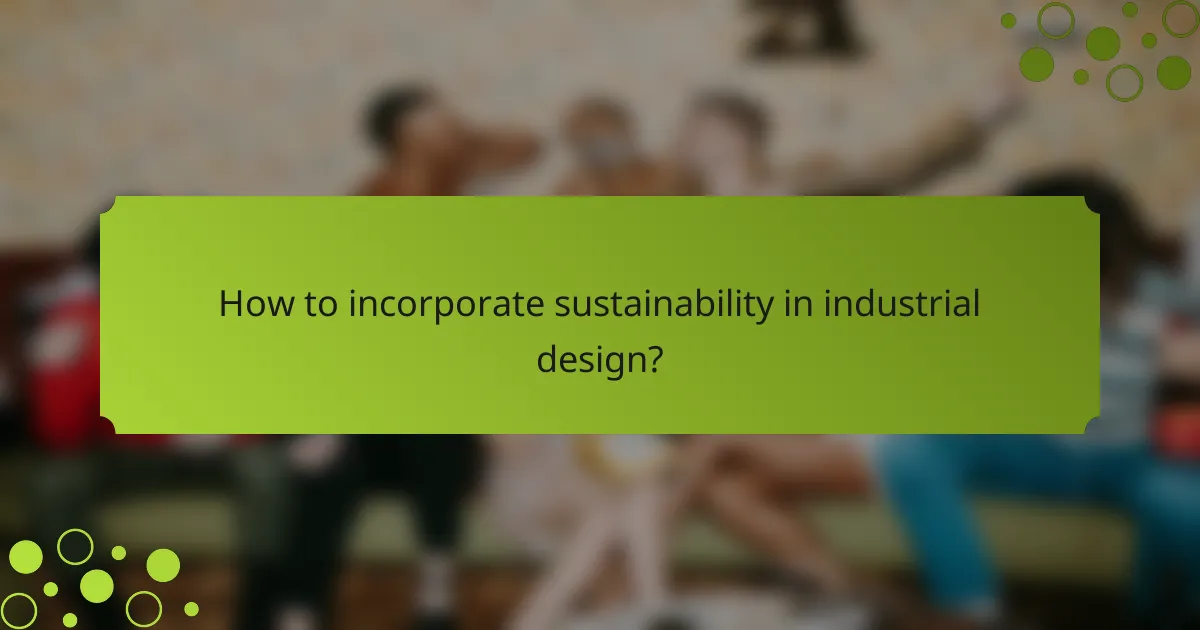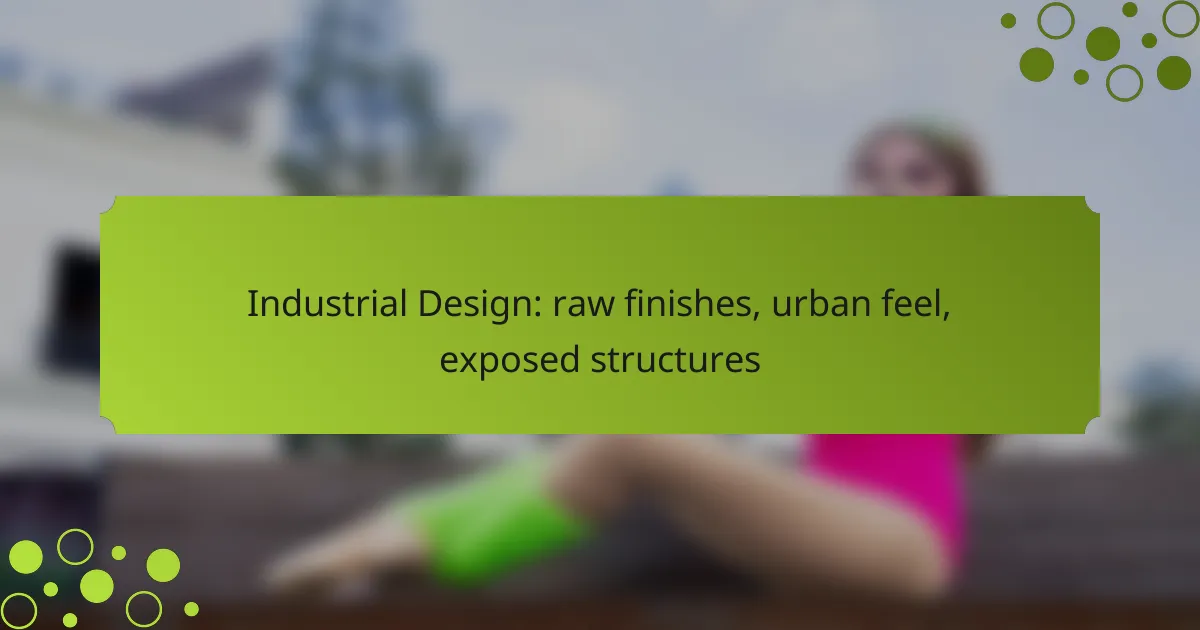Industrial design embraces raw finishes and an urban feel by utilizing materials that showcase their natural textures and imperfections. This style emphasizes open spaces, large windows, and exposed structures, creating an authentic atmosphere that highlights the character and functionality of the environment. By incorporating these elements, spaces become a reflection of their industrial heritage, merging rugged aesthetics with modern living.

How to achieve raw finishes in industrial design?
To achieve raw finishes in industrial design, focus on using materials that emphasize their natural textures and imperfections. This approach creates a rugged aesthetic that enhances the urban feel and highlights exposed structures.
Concrete surfaces
Concrete surfaces are a staple in industrial design, offering a durable and versatile option. They can be left in their natural state for a raw look or polished for a smoother finish. Consider using concrete for flooring, countertops, or accent walls to establish a strong foundation in your space.
When working with concrete, ensure proper curing and sealing to prevent moisture issues. Incorporating variations in color and texture can add depth and interest to the design.
Metallic textures
Metallic textures contribute to the industrial aesthetic by providing a sleek, modern edge. Options like steel, iron, and aluminum can be used in furniture, fixtures, and structural elements. Exposed metal beams or piping can enhance the raw feel of a space.
Choose finishes that highlight the material’s natural characteristics, such as brushed or oxidized surfaces. Be mindful of rust and corrosion, especially in humid environments, and consider protective coatings if necessary.
Wood finishes
Wood finishes add warmth and contrast to the coldness of metal and concrete in industrial design. Opt for reclaimed wood to enhance the raw aesthetic while promoting sustainability. Use it in furniture, wall paneling, or flooring for a rustic touch.
When selecting wood, consider its grain patterns and color variations, which can create visual interest. Avoid overly polished finishes to maintain the raw, unfinished look that defines industrial design.
Reclaimed materials
Reclaimed materials are ideal for achieving a raw finish while being environmentally conscious. Sourcing materials from old buildings, furniture, or pallets can introduce unique textures and histories into your design. These materials often come with character marks that enhance their appeal.
When using reclaimed materials, ensure they are properly treated for safety and durability. This may involve cleaning, sanding, or applying finishes that protect the material without compromising its raw look.
Natural stone
Natural stone, such as granite, slate, or limestone, provides a rugged yet sophisticated element in industrial design. Its inherent variations in color and texture contribute to a raw finish that complements other materials like metal and wood. Use stone for countertops, flooring, or accent walls.
Consider the weight and installation requirements of natural stone, as it can be heavy and may require professional installation. Seal the stone to protect it from stains while maintaining its natural appearance.

What urban feel elements enhance industrial design?
Urban feel elements that enhance industrial design include open floor plans, large windows, exposed brick walls, and minimalist furniture. These features create a spacious, airy environment while emphasizing raw materials and structural elements typical of industrial aesthetics.
Open floor plans
Open floor plans are a hallmark of industrial design, promoting a sense of spaciousness and fluidity. By eliminating unnecessary walls, these layouts encourage natural light to flow freely and facilitate social interaction. Consider using zoning techniques, such as area rugs or furniture arrangements, to define different spaces within the open layout.
When designing an open floor plan, aim for a cohesive style that blends various functional areas, like living, dining, and kitchen spaces. This approach not only enhances the urban feel but also maximizes the use of available square footage.
Large windows
Large windows are essential for creating an urban feel in industrial design, allowing abundant natural light to illuminate the space. They often feature metal or wooden frames that complement the raw finishes typical of industrial aesthetics. Consider installing floor-to-ceiling windows or oversized panes to enhance the connection between indoor and outdoor environments.
In urban settings, large windows can also provide stunning views of the cityscape, adding to the overall ambiance. Ensure that window treatments are minimal to maintain the open, airy feel and to showcase the architectural beauty of the windows themselves.
Exposed brick walls
Exposed brick walls serve as a defining feature of industrial design, adding texture and warmth to the space. They can be left in their natural state or painted to match the overall color scheme, providing versatility in design. When incorporating exposed brick, consider the condition of the wall; it should be structurally sound and free of moisture issues.
Incorporating exposed brick can also create a focal point in a room, drawing attention and enhancing the urban feel. Pairing brick walls with other raw materials, such as metal or wood, can further enrich the industrial aesthetic.
Minimalist furniture
Minimalist furniture complements the industrial design by emphasizing simplicity and functionality. Pieces are often made from materials like metal, wood, or leather, reflecting the raw finishes characteristic of this style. Look for furniture with clean lines and a streamlined silhouette to maintain an uncluttered appearance.
When selecting minimalist furniture, prioritize quality and durability, as these pieces should withstand daily use while contributing to the overall aesthetic. Avoid overcrowding the space; instead, choose a few statement pieces that enhance the urban feel without overwhelming the design.

How do exposed structures influence design aesthetics?
Exposed structures significantly enhance design aesthetics by showcasing the building’s framework and materials, creating a raw and urban feel. This approach emphasizes functionality while adding character, making spaces feel more authentic and connected to their industrial roots.
Visible beams and trusses
Visible beams and trusses serve as both structural elements and design features, contributing to an open and airy atmosphere. They can be made from materials like steel or wood, which can be left in their natural state or treated for visual appeal. The choice of finish can dramatically affect the overall ambiance, with raw finishes often adding warmth and texture.
When incorporating visible beams, consider the scale of the space. In larger areas, wider beams may be necessary for structural support, while smaller spaces might benefit from lighter, more delicate trusses to avoid overwhelming the design.
Unfinished pipes and ducts
Unfinished pipes and ducts are integral to the industrial aesthetic, revealing the inner workings of a space. Leaving these elements exposed can create a sense of authenticity and ruggedness, appealing to those who appreciate the beauty in imperfection. They can also be painted in bold colors to add visual interest or left in their raw state for a more subdued look.
When designing with exposed pipes and ducts, ensure they are clean and well-maintained to prevent any negative impact on the overall aesthetic. Consider their placement carefully to avoid cluttering the visual lines of the space.
Structural integrity as design
Emphasizing structural integrity as a design element can transform how spaces are perceived. By showcasing the strength and functionality of materials, designers can create a narrative around the building’s construction, making it a focal point. This approach often involves using materials that are both durable and visually appealing, such as concrete, steel, or reclaimed wood.
To effectively incorporate structural integrity into design, focus on balance and proportion. Highlight key structural elements while ensuring they harmonize with other design features. This balance can enhance the overall aesthetic while maintaining the building’s functionality.

What are the key materials for industrial design in Australia?
The key materials for industrial design in Australia include steel, iron, glass, concrete, and recycled materials. These elements contribute to the raw finishes and urban feel characteristic of this design style, emphasizing functionality and aesthetic appeal.
Steel and iron
Steel and iron are foundational materials in industrial design, known for their strength and durability. They can be used in structural elements, furniture, and decorative features, providing a rugged, urban aesthetic.
When selecting steel or iron, consider the finish—raw, polished, or painted options can dramatically change the look. Ensure compliance with local building codes, especially for structural applications, to maintain safety and integrity.
Glass and concrete
Glass and concrete are essential for creating open, airy spaces while maintaining an industrial vibe. Glass allows natural light to flood interiors, enhancing the sense of space, while concrete offers a robust, minimalist backdrop.
Using large glass panels can create seamless transitions between indoor and outdoor areas, ideal for Australian climates. Concrete can be left raw or treated for a more refined finish, depending on the desired look.
Recycled materials
Recycled materials are increasingly popular in industrial design, promoting sustainability while adding unique character. Items like reclaimed wood, metal scraps, and repurposed fixtures can be creatively integrated into designs.
When using recycled materials, verify their quality and structural integrity. This approach not only reduces waste but also tells a story, making spaces more engaging and environmentally friendly.

How to incorporate sustainability in industrial design?
Incorporating sustainability in industrial design involves using eco-friendly materials, minimizing waste, and optimizing energy efficiency. Designers should focus on creating products that are not only functional but also environmentally responsible throughout their lifecycle.
Use of Recycled Materials
Utilizing recycled materials is a key strategy for sustainable industrial design. This can include metals, plastics, and wood that have been repurposed from previous products. By choosing recycled components, designers can significantly reduce the demand for new raw materials and lower the overall environmental impact.
When selecting recycled materials, consider their availability and the quality they offer. For example, reclaimed wood can add character and durability, while recycled aluminum can provide strength without the environmental cost of new extraction processes.
Energy Efficiency in Production
Energy efficiency is crucial in the production phase of industrial design. Implementing energy-efficient machinery and processes can reduce the carbon footprint of manufacturing. This might involve using renewable energy sources, such as solar or wind, to power production facilities.
Designers should also consider the energy consumption of the products themselves. For instance, designing products that require less energy to operate can lead to significant long-term savings for consumers and a reduced environmental impact.
Design for Longevity and Repairability
Creating products that are durable and easy to repair is essential for sustainable industrial design. This approach minimizes waste by extending the product’s lifespan and reducing the frequency of replacements. Designers should focus on modular designs that allow for easy upgrades and repairs.
Encouraging consumers to repair rather than replace can be supported by providing clear instructions and necessary tools. This not only promotes sustainability but also fosters a culture of resourcefulness and responsibility among users.
Minimalist Aesthetic with Raw Finishes
A minimalist aesthetic that embraces raw finishes can enhance sustainability by reducing the need for additional materials and processes. Exposed structures and unfinished surfaces often require less energy and fewer resources to produce, aligning with eco-friendly principles.
This design approach can create an urban feel that resonates with contemporary consumers. For example, using concrete, steel, or reclaimed wood in their natural states can produce striking visual effects while minimizing environmental impact.
